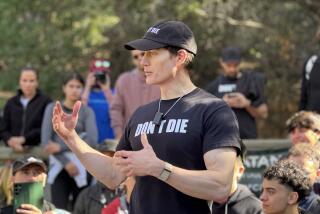Going Strong
- Share via
Bill Phillips will not leave your local bookstore. Diet-and-exercise guides come and go, but for the past three years, Phillips’ handsome, grinning mug and bulging biceps--which grace the cover of his book “Body-for-Life”--have greeted anyone who wanders into the fitness section.
As of mid-May, this slender volume of workout plans, nutritional counseling and motivational backslapping had been on the New York Times bestseller list for more than two years (122 weeks). That’s a remarkable feat, given the glut of diet guides published each year and considering that the book costs $26--pricey for a self-help manual. (“Dr. Atkins’ New Diet Revolution,” by Dr. Robert Atkins, has been on the same list for 250 weeks, but you can pick up a copy in paperback for as little as $7.)
In short, the book has become a publishing phenomenon. Today, there are 3 million copies in print (publisher HarperCollins initially printed 20,000), and it has been translated into 15 languages. Not since Barry Sears’ “The Zone” made millions of Americans swear off pasta and potatoes during the 1990s has a book captured the imaginations of so many people in pursuit of shapelier bodies.
Some nutritionists dismiss Bill Phillips as a latter-day Atkins or Sears or another self-styled guru preaching a high-protein, low-calorie diet. But “Body-for-Life” stands apart from most other diet books in one significant way: More than any other in recent memory, Phillips’ guide stresses the importance of building muscle while trimming flab.
Readers won’t find a lot of talk about reducing the risk for heart disease or cancer in “Body-for-Life.” A unique feature of Phillips’ book--dozens of before-and-after photos of people who buffed their bodies by following his creed--may be the book’s strongest selling point.
Of course, Phillips didn’t invent the concept of before-and-after photos. But no other fitness czar has ever used them to such powerful effect. As publisher of a bodybuilding magazine called Muscle Media, Phillips ran a contest in 1997, challenging his readers to bulk up and slim down over a 12-week period. More than 54,000 people entered the contest, and many of their pre- and post-challenge photos are reproduced in “Body-for-Life.” (The contest, now known as the Body-for-Life Challenge, is still held every year.) Some metamorphoses are astonishing: Toothpick arms sprout chiseled biceps. Chests puff up. Belly rolls disappear, replaced by wasp waists and six-pack abs.
It’s enough to make people wonder: Are they real? Phillips’ manager, Jim Nagle, insists the photos were taken by the contestants themselves, and there’s no evidence that any of the images were doctored. “Body-for-Life” also includes inspirational stories about people who boosted their self-esteem and built muscle by following advice Phillips offered in his magazine.
“If it were just me saying what works and what doesn’t, in terms of eating right and exercising, I don’t think the book would be the success that it is,” says Phillips by telephone from his home in Golden, Colo. Readers see the striking transformations achieved by others, Phillips says, and start thinking “maybe this really will work for me.”
Started With Newsletter About Bodybuilding
Phillips, 37, grew up in Golden, the youngest son of an attorney and a stay-at-home mom (he has an older brother and sister). “It was a real small-town lifestyle,” Phillips says, recalling days spent hiking in the Rocky Mountains. He participated in sports too--football, wrestling, and track and field--but one day realized he enjoyed training and getting in shape more than competing on the playing field.
To make tuition money while attending the University of Colorado, he self-published a newsletter that contained information about bodybuilding and strength training, basing his tips on research gleaned from anatomy and physiology books and wisdom he picked up from fellow devotees of the weight room.
Phillips admits to taking anabolic steroids to pump up his physique in the 1980s but now publicly condemns the use of performance-enhancing drugs. However, Phillips says dietary supplements are one key to a fitter figure--so much that he bought a company called EAS, for Experimental and Applied Sciences, in 1995. EAS manufactures and sells a variety of dietary supplements, including muscle-building pills and powders such as creatine. Phillips owned EAS until 1999, when he sold it to a group called North Castle Partners. He retains a minority interest.
The eight-page, photocopied newsletter Phillips produced from his apartment eventually became Muscle Media magazine, which Phillips says today has 750,000 regular readers.
Phillips is not a certified fitness trainer and, although he took premed classes at the University of Colorado, he never earned a degree. Nonetheless, Bill Phillips has become the man legions of Americans turn to for health advice.
Phillips doesn’t pretend his plan is easy. “Body-for-Life is a hard program, a rigorous program,” he says.
Consider Rosie O’Neill, 22, a publicist from Brentwood, who dropped from a size 6 to a size 4 in her first five weeks on the Body-for-Life plan. Three days a week, she spends 20 to 30 minutes on a treadmill or elliptical trainer. That may not sound like much, but Phillips’ plan calls for Body-for-Lifers to hit four “high points” during any aerobic workout. This technique is also known as interval training, that is, alternating stints of moderate exercise with bursts of all-out hustle.
Every other day, O’Neill lifts weights for about 50 minutes, pausing only long enough to catch her breath between routines and pushing her muscles to the point of exhaustion. Her daily diet consists of six modest meals, each containing equal portions of protein and “quality” carbohydrates, such as potatoes (no butter or sour cream) or brown rice. Sugary, high-fat foods? Forget ‘em--except on the seventh day of the week, when Phillips says it’s OK to slack off and eat whatever you like. (O’Neill splurges on chocolate.)
You may wonder how the average person finds time to prepare six meals a day. Phillips is a step ahead of you. He advises readers to “save time and money” by drinking Myoplex shakes, which are made by EAS. In “Body-for-Life,” Phillips explains that you don’t have to use Myoplex shakes, which cost about $2.50 per serving, to get lean and ripped. But he mentions that he drinks them every day, and he points out that most people who compete in the Body-for-Life Challenge guzzle the stuff.
One Myoplex shake contains 42 grams of protein--the tissue-building nutrient Phillips says is in short supply in the American diet. As a nation, he says in “Body for Life,” we are “overfed on carbohydrates. Underfed on protein.”
But he has a solution. Drink three Myoplex shakes a day, as Phillips suggests in “Body-for-Life,” and you’ll be downing 126 grams of protein. That’s in addition to the protein found in the lean beef, poultry and fish that are also part of the meal plan.
“Wow. That’s an awful lot of protein,” said Kathleen Zelman, a registered dietitian in Atlanta and a spokeswoman for the American Dietetic Assn. For starters, Zelman says, all that protein must be processed by the kidneys, so anyone who has been diagnosed with a renal disorder should know that Phillips’ diet could further burden their kidney functioning (which could lead to dehydration).
She’s also skeptical of the claim that Americans eat too little protein. “The typical American has no problem getting enough protein in their diet,” she says.
In fact, according to the U.S. Department of Agriculture, the average American consumes about 75 grams of protein each day. Dietary guidelines set by the National Academy of Sciences call for adult men to consume 63 grams; women require 50 grams. Most nutritionists agree that these standards have a large built-in margin of safety. Though sports nutritionists often counsel competitive bodybuilders and endurance athletes to load up on protein, the experts contacted for this article agreed that the average person who adopts the “Body-for-Life” exercise regimen would probably not require high doses of the nutrient.
“The protein is there mostly to fill the void of you being hungry,” says exercise physiologist David Pearson, of Ball State University, in Muncie, Ind., who is an advisor for Men’s Health magazine. The Body-for-Life plan would be very low in calories without the protein shakes, he points out, so they serve largely to quiet growling stomachs. “Protein takes a long time to get through the digestive system, so you feel fuller.”
Assuming you don’t have kidney disease, the extra protein has little effect; your body excretes what it doesn’t use in the urine and feces, says Pearson.
Other fitness experts question whether it’s wise for couch potatoes to leap right into a high-intensity workout, such as the conditioning program in “Body-for-Life.”
“That runs against the grain of what we normally recommend for weight loss,” says trainer and physiologist Rudy Dressendorfer, a spokesman for the American College of Sports Medicine. “Can people trying to lose weight sustain high-intensity exercise without overdoing it?” High-intensity exercise often leads to injuries, says Dressendorfer, which can sabotage a fitness plan.
Pearson says that people lose weight on the Body-for-Life plan simply because they’re expending more calories through exercise than they’re consuming. “There’s no magic to it,” he says.
‘Experts Still Have Some Learning to Do’
Phillips says his critics are blinded by their book learning. “To be a health expert, you have to be healthy. Having knowledge about how the body works and what constitutes proper nutrition is one thing. Being able to apply that information is another,” he says. “I think a lot of experts still have some learning to do.”
Phillips insists that his followers need extra protein to compensate for the wear and tear on their muscles. He also dismisses fears that his exercise plan is too aggressive. “I don’t think the best way to learn to swim is to go in the shallow end and splash around,” quips Phillips.
He can afford to be brash--literally. Although Phillips, who is single, won’t say how much he earned on the sale of EAS, he now owns homes in Los Angeles and Hawaii, as well as Colorado. He recently started a small publishing company called High Point Media to publish “empowering books” but has plenty of time to surf and scuba dive. And he has donated all his royalties from sales of “Body-for-Life” to the Make-A-Wish Foundation--about $3 million so far, according to Phillips.
And if his method leads to thinner thighs and bigger pecs, Phillips’ fans seem happy to guzzle on. When told that some nutritionists and exercise experts are dubious of Phillips’ protein-friendly prescription, Rosie O’Neill was philosophical.
“If the high-protein diet works for you, doesn’t hurt you and gives you great results,” she said, “then it’s the right approach.”
More to Read
Sign up for our Book Club newsletter
Get the latest news, events and more from the Los Angeles Times Book Club, and help us get L.A. reading and talking.
You may occasionally receive promotional content from the Los Angeles Times.









